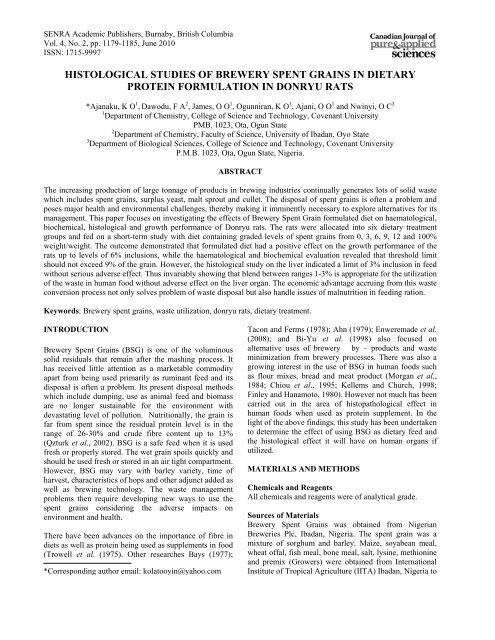Download (5Mb) - Covenant University Repository
Download (5Mb) - Covenant University Repository
Download (5Mb) - Covenant University Repository
Create successful ePaper yourself
Turn your PDF publications into a flip-book with our unique Google optimized e-Paper software.
SENRA Academic Publishers, Burnaby, British Columbia<br />
Vol. 4, No. 2, pp. 1179-1185, June 2010<br />
ISSN: 1715-9997<br />
HISTOLOGICAL STUDIES OF BREWERY SPENT GRAINS IN DIETARY<br />
PROTEIN FORMULATION IN DONRYU RATS<br />
*Ajanaku, K O 1 , Dawodu, F A 2 , James, O O 1 , Ogunniran, K O 1 , Ajani, O O 1 and Nwinyi, O C 3<br />
1 Department of Chemistry, College of Science and Technology, <strong>Covenant</strong> <strong>University</strong><br />
PMB. 1023, Ota, Ogun State<br />
2 Department of Chemistry, Faculty of Science, <strong>University</strong> of Ibadan, Oyo State<br />
3 Department of Biological Sciences, College of Science and Technology, <strong>Covenant</strong> <strong>University</strong><br />
P.M.B. 1023, Ota, Ogun State, Nigeria.<br />
ABSTRACT<br />
The increasing production of large tonnage of products in brewing industries continually generates lots of solid waste<br />
which includes spent grains, surplus yeast, malt sprout and cullet. The disposal of spent grains is often a problem and<br />
poses major health and environmental challenges, thereby making it imminently necessary to explore alternatives for its<br />
management. This paper focuses on investigating the effects of Brewery Spent Grain formulated diet on haematological,<br />
biochemical, histological and growth performance of Donryu rats. The rats were allocated into six dietary treatment<br />
groups and fed on a short-term study with diet containing graded levels of spent grains from 0, 3, 6, 9, 12 and 100%<br />
weight/weight. The outcome demonstrated that formulated diet had a positive effect on the growth performance of the<br />
rats up to levels of 6% inclusions, while the haematological and biochemical evaluation revealed that threshold limit<br />
should not exceed 9% of the grain. However, the histological study on the liver indicated a limit of 3% inclusion in feed<br />
without serious adverse effect. Thus invariably showing that blend between ranges 1-3% is appropriate for the utilization<br />
of the waste in human food without adverse effect on the liver organ. The economic advantage accruing from this waste<br />
conversion process not only solves problem of waste disposal but also handle issues of malnutrition in feeding ration.<br />
Keywords: Brewery spent grains, waste utilization, donryu rats, dietary treatment.<br />
INTRODUCTION<br />
Brewery Spent Grains (BSG) is one of the voluminous<br />
solid residuals that remain after the mashing process. It<br />
has received little attention as a marketable commodity<br />
apart from being used primarily as ruminant feed and its<br />
disposal is often a problem. Its present disposal methods<br />
which include dumping, use as animal feed and biomass<br />
are no longer sustainable for the environment with<br />
devastating level of pollution. Nutritionally, the grain is<br />
far from spent since the residual protein level is in the<br />
range of 26-30% and crude fibre content up to 13%<br />
(Qzturk et al., 2002). BSG is a safe feed when it is used<br />
fresh or properly stored. The wet grain spoils quickly and<br />
should be used fresh or stored in an air tight compartment.<br />
However, BSG may vary with barley variety, time of<br />
harvest, characteristics of hops and other adjunct added as<br />
well as brewing technology. The waste management<br />
problems then require developing new ways to use the<br />
spent grains considering the adverse impacts on<br />
environment and health.<br />
There have been advances on the importance of fibre in<br />
diets as well as protein being used as supplements in food<br />
(Trowell et al. (1975). Other researches Bays (1977);<br />
*Corresponding author email: kolatooyin@yahoo.com<br />
Tacon and Ferms (1978); Ahn (1979); Enweremade et al.<br />
(2008); and Bi-Yu et al. (1998) also focused on<br />
alternative uses of brewery by – products and waste<br />
minimization from brewery processes. There was also a<br />
growing interest in the use of BSG in human foods such<br />
as flour mixes, bread and meat product (Morgan et al.,<br />
1984; Chiou et al., 1995; Kellems and Church, 1998;<br />
Finley and Hanamoto, 1980). However not much has been<br />
carried out in the area of histopathological effect in<br />
human foods when used as protein supplement. In the<br />
light of the above findings, this study has been undertaken<br />
to determine the effect of using BSG as dietary feed and<br />
the histological effect it will have on human organs if<br />
utilized.<br />
MATERIALS AND METHODS<br />
Chemicals and Reagents<br />
All chemicals and reagents were of analytical grade.<br />
Sources of Materials<br />
Brewery Spent Grains was obtained from Nigerian<br />
Breweries Plc, Ibadan, Nigeria. The spent grain was a<br />
mixture of sorghum and barley. Maize, soyabean meal,<br />
wheat offal, fish meal, bone meal, salt, lysine, methionine<br />
and premix (Growers) were obtained from International<br />
Institute of Tropical Agriculture (IITA) Ibadan, Nigeria to

















